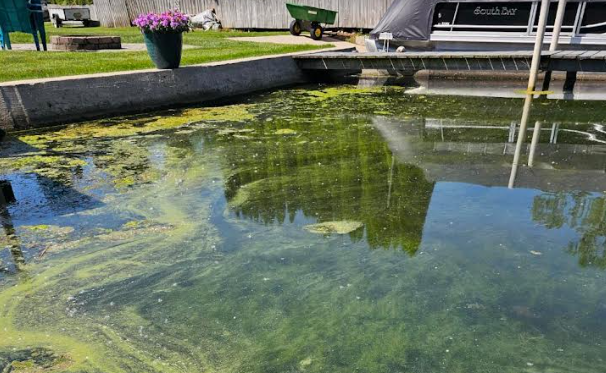
News Release
WINONA LAKE — This week, the Lilly Center for Lakes & Streams identified a highly toxic blue-green algae bloom in Big Chapman Lake.
As a result, the Lilly Center urges lake residents to exercise caution and look for tell-tale signs of a blue- green algae bloom such as an oil spill-like appearance. When in doubt, stay out, the Lilly Center said in a news release issued Friday.
Thanks to a tip from a Chapman Lake resident, Lilly Center researchers conducted an
analysis of microcystin, a blue-green algae toxin, in the lake to identify any potential
threats.
The Indiana Department of Environmental Management’s threshold for pet safety is 0.8 parts per billion (ppb) and 8.0 ppb for human safety.
Initial lab results from water samples in the north channel of Nelly’s Bay indicated a toxin level of 160.4 ppb. Further tests showed that the bloom had dissipated somewhat and dropped to 1.7 ppb.
However, toxin results from a second channel in Nelly’s Bay showed a microcystin concentration of 41.3 ppb. Although the visible bloom may begin to dissipate in the
coming days, toxins may linger, the news release said.
Lake residents are encouraged take precautionary measures including avoiding contact
with the bloom, avoiding ingesting toxin-laden water, and rinsing lake water off with
fresh water. Pet owners are encouraged to keep their pets out of the water until after
the bloom has disappeared.
The main body of Big Chapman Lake had microcystin levels below the pet and human
safety threshold.Spotting a blue-green algae bloom is easy if you know the signs. A bloom will often have a pea soup or paint spill-like appearance and often be bright green or blue. Performing the “stick test” will help you identify the difference between harmless green algae and potentially toxic blue-green algae. Green algae is stringy and will hang off the stick, but blue-green algae will simply stir like paint.
If you spot a blue-green algae bloom or something you cannot identify, report it to the
Lilly Center by emailing lakes@grace.edu or calling 574-372-5281.
Supported by the K21 Health Foundation and the Kosciusko County Convention, Recreation, and Visitor Commission, the Lilly Center conducts weekly sampling on 14 lakes and at seven public beaches throughout Kosciusko County. Samples are processed in the Lilly Center's lab, and results are posted to our website each Friday, beginning June 7.
Sign up for weekly toxin notifications at lakes.grace.edu/microcystin.




